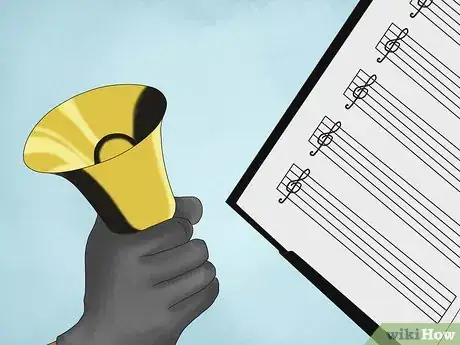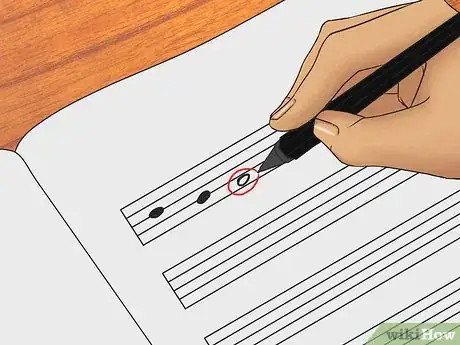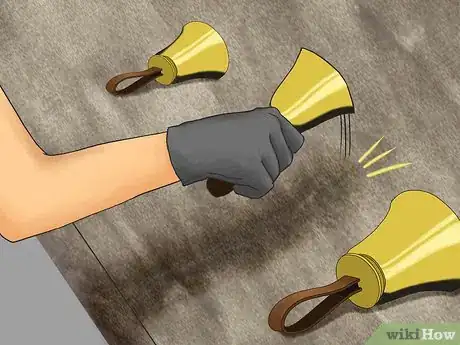wikiHow is a “wiki,” similar to Wikipedia, which means that many of our articles are co-written by multiple authors. To create this article, 21 people, some anonymous, worked to edit and improve it over time.
wikiHow marks an article as reader-approved once it receives enough positive feedback. In this case, 90% of readers who voted found the article helpful, earning it our reader-approved status.
This article has been viewed 108,053 times.
Learn more...
Handbells, while almost completely unheard of in some areas, are a unique instrument to play. They can be played in choirs, or even as a solo instrument and require using techniques that are not used on any other instrument. Hand bells offer a unique musical (and visual) experience that people of all ages and experience levels can enjoy.
Steps
-
1Find a handbell choir in your area. They're most common in churches, but some schools have them, or you may even be able to find a large community choir. All programs are different, so if you live in an area with more than one choir nearby, look into your options. Some programs are more structured and serious while others are more for fun. Especially in churches, the members are often older, but it's not unusual to see a handbell choir with people of many ages, or even one for young people only. Find one that you think you will feel comfortable being a part of.
- If there isn't an active choir in your area, you might want to find some other interested people and work to start one.
-
2Know some basic music fundamentals, or be prepared to learn them fairly quickly. You should know how to read music. Handbell music is written on a grand staff, much like piano music, meaning you should be able to read treble clef and at least some bass clef, depending on how many octaves of hand bells are in your choir. You will need to be able to internalize a beat, since you may or may not have a conductor. A basic knowledge of music theory (mainly chords) may also be helpful.[1]Advertisement
-
3Understand the basic idea of a handbell choir. A good way to think of a handbell choir is like a piano, where each person only controls a few keys. Most small church or school choirs only have two or three octaves of bells, and you will probably be given two bells to start off. The bells are to be kept in keyboard order (lowest to highest, when going left to right, and in chromatic order) as much as possible, and you will take your place between the people playing the closest bells to you. When hand bell music is played well, it can be very beautiful and unique-sounding, which is why it's so popular in churches. Handbells are also as much of a visual art as they are a musical art; you'll see why if you watch a choir perform. They all ring with the same technique.
-
4Familiarize yourself with the anatomy of a handbell. The bells vary in size based on their pitch; obviously, lower bells are larger and thus heavier, and vice versa. The handle should indicate the note (pitch as represented by a letter and octave number), and some brands make the handles of flat/sharp bells black and leave the others white, much like the coloring of a piano keyboard. Inside the bell is the clapper, which is the part that strikes the bell and causes it to produce sound. There is a rotating piece on the clapper that can be used to control volume. A solid edge hitting the bell produces the loudest sound, while rotating the clapper to a setting with a hole in it makes a softer sound.[2]
Basic Ringing Technique
-
1Begin by putting on gloves (worn by most choirs to avoid smudging or tarnishing the handbells) and picking up two bells and holding them in front of your chest, either angling towards you or facing straight up, depending on the way your choir has chosen to stand with the bells up. Some brands have a marking on them indicating which way you should be holding them; for instance, Malmark bells have a picture of a bell on the handle on one side, which should be facing you.
-
2To ring one bell, move it forward by extending it away from your body in a circular motion, with the handle moving slightly ahead of the bell. When you reach the bottom of your circle, snap your wrist. This should produce a sound. Continue the circle until the bell comes to rest at your chest, where it started.[3]
-
3Damp the bell by touching it lightly to your chest when you complete the circle. Damping the bell causes it to stop vibrating immediately instead of letting the sound taper off and continue ringing for a while. If you are damping a very large bell, you may need to place your hand on it as well. Alternatively, bells of all sizes can be damped on the table or any other soft surface.
- Sometimes, creative ways of damping bells can be used to add to the visual appeal of a handbell choir's performance.
-
4Repeat until you are comfortable with this motion, and then try with the other bell in your other hand. You should be able to ring well with both hands, regardless of which is your dominant.
-
5Understand that the length of time you spend ringing (and thus, the size of your circle) varies according to the length of the note you are playing. When you're playing whole notes, take your time making a large, graceful circle with a dainty wrist snap. When you're playing eighth notes, the bell shouldn't move far from your body at all.
Reading and Playing Music
-
1Understand your role as a member of a handbell choir. You only control two or three of the notes in the whole "keyboard" right now. You must work to play together with the other members of your choir to sound like one instrument.[4]
-
2Mark your music, if you find it helpful at first. If you're playing F4 and G4, marking all of your notes with a highlighter or pencil before you start playing should make it easier to keep track of where you're playing. In time, you may grow out of needing to do this.
-
3Keep the beat. If you have a conductor to watch, that's great, but not all choirs do. Learn to count in your head or subtly tap your foot so that you know when to play.
-
4Have fun. Playing handbells is a musical experience different from playing any other instrument that many people do not ever get to have. Enjoy what you're doing, or it's not worth doing in the first place.
More Advanced Techniques
-
1Once you have mastered basic handbell playing fundamentals, move on to more advanced techniques. Handbell music has its own special markings and directions that you will never see on other music. For instance, instead of trilling, handbells "shake" (usually indicated by the letters Sk on the music). This is exactly what it sounds like; instead of just playing the note, letting it ring, and damping it, you shake the bell for the notated length of time. There are also markings that tell you to damp in certain ways; for instance, damping on the table, or purposely bringing the bell to the table with force as to create a certain sound.[5]
-
2Learn to play bells four- and six-in-hand. This technique makes it much easier to play more than two bells at once. To do this, put two bells together through their handles in a way that they are all facing a different direction. You will want two or three bells in each hand. You will discover that you can move your arm one way to play one of the notes in that hand and a different way to play the other one. Obviously, this is easier with smaller bells.
-
3Try plucking the bells. Sometimes this is written into the music, and other times it is a decision made by the director. To pluck, lay the bells down on the table as you normally would, and lift up the clappers and gently drop them, instead of ringing.[6]
-
4Try playing with mallets. To do this, lay the bells down on the padded table (in keyboard order, of course), and gently tap them with mallets instead of playing.
- Be aware that you do need to use special mallets intended for handbells. Smaller ones are for smaller bells, and larger ones are for larger bells. Often, the range of bells a particular size of mallet is used for will be marked somewhere on the handle.
-
5Venture into the art of solo handbells. There are many different ways to do this. Some soloists set up a table with an octave or two of handbells and play all of them, usually with some kind of accompaniment. Others play simple melodies four- or six-in-hand. It's all up to you.
Community Q&A
-
QuestionCan I ring a b flat with b natural bell?
 Community AnswerNo. B flat and B natural are different notes, and each bell only plays one note.
Community AnswerNo. B flat and B natural are different notes, and each bell only plays one note. -
QuestionWhere do you buy these handbells for a choir?
 Community AnswerThe two main handbell sellers in the U.S. are Malmark and Schulmerich. Buying online is probably easiest.
Community AnswerThe two main handbell sellers in the U.S. are Malmark and Schulmerich. Buying online is probably easiest. -
QuestionAre g# and Ab the same bell?
 Community AnswerYeah. Explaining here would take forever, but Google "chromatic scale" for more information.
Community AnswerYeah. Explaining here would take forever, but Google "chromatic scale" for more information.
Warnings
- Be careful to avoid dropping bells, hitting them against each other, or otherwise subjecting them to impact. Dents in the bells can cause them not only to be less pretty but also go out of tune.⧼thumbs_response⧽
References
- ↑ http://neilhawes.com/sstheory/theory26.htm
- ↑ https://www.makingmusic.org.uk/resource/introduction-handbell-ringing
- ↑ https://www.youtube.com/watch?v=hBiGOrUwbsc
- ↑ https://www.youtube.com/watch?v=xzVJJmkSRU0
- ↑ https://www.handbellworld.com/music/HandbellNotation.cfm
- ↑ https://blog.cph.org/worship/7-handbell-techniques-for-unique-sounds














































































